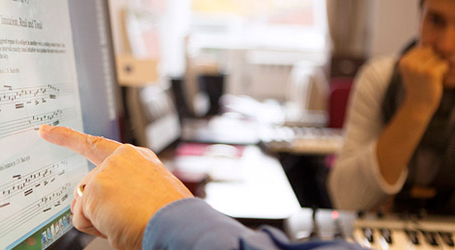Peter Lucas Hulen
- hulenp@wabash.edu
Teaching Composition
 Philosophies of teaching sometimes include the notion that students learn on the basis of what is already known. This might be extended to teaching and learning music composition. But students can also be creatively limited by what they already know.
Philosophies of teaching sometimes include the notion that students learn on the basis of what is already known. This might be extended to teaching and learning music composition. But students can also be creatively limited by what they already know.
Most college-level composition students have been trained in tonal harmony and voice leading, and have considerable musical experience, though it might supply little toward comprehending musical materials in their own right. Popular notions about what it means to compose also get in the way, and tonal harmony—while providing invaluable concepts—tends to put students in a procedural straightjacket.
The organization of musical materials requires them to be understood abstractly and objectively. Helping students understand the principles of organization themselves as materials of composition is an even taller order. A good way to start is by having them grapple with basic elements. They will not "grapple" if those elements suggest the all too familiar procedures of tonal harmony and voice leading. Students will operate on autopilot and never learn to look at materials objectively.
Students of composition need to be kicked out of the tonal milieu. This does not mean that tonal elements are unworthy; it means that students cannot as easily objectify materials to which they have become habituated. Once students grasp materials abstractly and objectively they can return to tonal elements (if they want) with a conceptual understanding that transcends previous experience. They make better composers for having stepped outside the familiar and seen the previously unseen.
Making procedural departures from functional tonality while maintaining connection with what is already known is a challenge. Non-atonal styles of the early 20th century make such a departure while still bridging the gap between known and unknown. Procedures traceable in the music of Mahler, Debusy, Ravel, Satie, early Stravinsky, Bartok et al (even some Brahms and Wagner) apply elements that are at once familiar and accessible—motif, melody, phrase, scale, diatonic set, tertian harmony, etc.—yet separate from the harmonic progression and voice leading specific to the major-minor tonal system.
Progression and voice leading in these styles are largely modal; their elements and procedures provide an introduction to materials in their own right. These styles incorporate extended tertian and quartal harmonies, and provide a natural basis for introducing synthetic, secundal, pandiatonic, atonal and dodecaphonic procedures. In all these, application and control of dissonance are separate from the dominant-tonic axis.
Another useful approach in teaching introductory composition is to provide students with specific assignments predefining some elements, while leaving others to students' discretion. This brings the experience of composing down to a level of individual elements, so students can practice conceptualizing and inventing them one at a time. This eventually leads to the development of a more complex, integral and intuitive operation of the creative process.
This was the approach taken by my first composition teacher Theodore Hansen at the University of Tulsa. Even though I have followed his approach for years, I find myself embodying it in a more powerful and intuitive way as I move into the career and life stage he was at when he was my teacher.